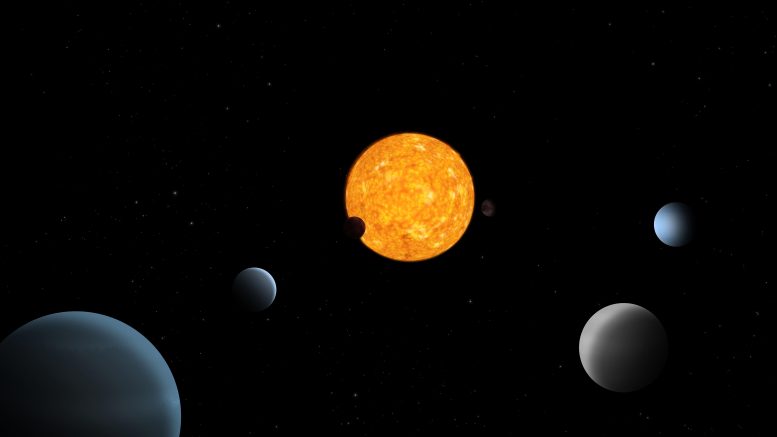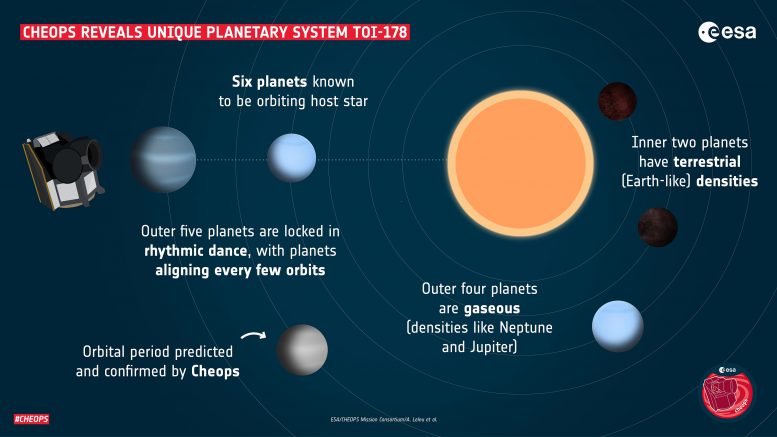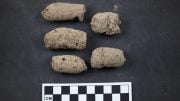
This is an artist’s impression of the TOI-178 planetary system, which was revealed by ESA’s exoplanet watcher Cheops. The system consists of six exoplanets, five of which are locked in a rare rhythmic dance as they orbit their central star. In this artist impression, the relative sizes of the planets are to scale, but not the distances and the size of the star. Credit: ESA
ESA’s exoplanet mission Cheops has revealed a unique planetary system consisting of six exoplanets, five of which are locked in a rare rhythmic dance as they orbit their central star. The sizes and masses of the planets, however, don’t follow such an orderly pattern. This finding challenges current theories of planet formation.
The discovery of increasing numbers of planetary systems, none like our own Solar System, continues to improve our understanding of how planets form and evolve. A striking example is the planetary system called TOI-178, some 200 light-years away in the constellation of Sculptor.
Astronomers already expected this star to host two or more exoplanets after observing it with NASA’s Transiting Exoplanet Survey Satellite (TESS). New, highly precise observations with Cheops, ESA’s Characterising Exoplanet Satellite that was launched in 2019, now show that TOI-178 harbors at least six planets and that this foreign solar system has a very unique layout. The team, led by Adrien Leleu of University of Geneva and the University of Bern in Switzerland, published their results today in Astronomy & Astrophysics.
One of the special characteristics of the TOI-178 system that the scientists were able to uncover with Cheops is that the planets – except the one closest to the star – follow a rhythmic dance as they move in their orbits. This phenomenon is called orbital resonance, and it means that there are patterns that repeat themselves as the planets go around the star, with some planets aligning every few orbits.
A similar resonance is observed in the orbits of three of Jupiter’s moons: Io, Europa, and Ganymede. For every orbit of Europa, Ganymede completes two orbits, and Io completes four (this is a 4:2:1 pattern).
In the TOI-178 system, the resonant motion is much more complex as it involves five planets, following an 18:9:6:4:3 pattern. While the second planet from the star (the first in the pattern) completes 18 orbits, the third planet from the star (second in the pattern) completes nine orbits, and so on.

This graphic shows a representation of the TOI-178 planetary system, which was revealed by ESA’s exoplanet watcher Cheops. In this graphic, the relative sizes of the planets are to scale, but not the distances and the size of the star. Credit: ESA/Cheops Mission Consortium/A. Leleu et al.
Initially, the scientists only found four of the planets in resonance, but by following the pattern the scientists calculated that there must be another planet in the system (the fourth following the pattern, the fifth planet from the star).
“We predicted its trajectory very precisely by assuming that it was in resonance with the other planets,” Adrien explains. An additional observation with Cheops confirmed that the missing planet indeed existed in the predicted orbit.
After they had uncovered the rare orbital arrangements, the scientists were curious to see whether the planet densities (size and mass) also follow an orderly pattern. To investigate this, Adrien and his team combined data from Cheops with observations taken with ground-based telescopes at the European Southern Observatory’s (ESO) Paranal Observatory in Chile.
But while the planets in the TOI-178 system orbit their star in a very orderly manner, their densities do not follow any particular pattern. One of the exoplanets, a dense, terrestrial planet like Earth is right next to a similar-sized but very fluffy planet – like a mini-Jupiter, and next to that is one very similar to Neptune.
“This is not what we expected, and is the first time that we observe such a setup in a planetary system,” says Adrien. “In the few systems we know where the planets orbit in this resonant rhythm, the densities of the planets gradually decrease as we move away from the star, and it is also what we expect from theory.”
Catastrophic events such as giant impacts could normally explain large variations in planet densities, but the TOI-178 system would not be so neatly in harmony if that had been the case.
“The orbits in this system are very well ordered, which tells us that this system has evolved quite gently since its birth,” explains co-author Yann Alibert from the University of Bern.
Revealing the complex architecture of the TOI-178 system, which challenges current theories of planet formation, was made possible thanks to almost 12 days of observations with Cheops (11 days of continuous observations, plus two shorter observations).
“Solving this exciting puzzle required quite some effort to plan, in particular to schedule the 11-day continuous observation needed in order to catch the signatures of the different planets,” says ESA Cheops project scientist Kate Isaak. “This study highlights very nicely the follow-up potential of Cheops – not only to better characterize known planets, but to hunt down and confirm new ones.”
Adrien and his team want to continue to use Cheops to study the TOI system in even more detail.
“We might find more planets that could be in the habitable zone – where liquid water might be present on the surface of a planet – which begins outside of the orbits of the planets that we discovered to date,” says Adrien. “We also want to find out what happened to the innermost planet that is not in resonance with the others. We suspect that it broke out of resonance due to tidal forces.”
Astronomers will use Cheops to observe hundreds of known exoplanets orbiting bright stars.
“Cheops will not only deepen our understanding of the formation of exoplanets, but also that of our own planet and the Solar System,” adds Kate.
For more on this unique planetary system, read Puzzling Six-Exoplanet System Discovered With Resonant Rhythmic Movement.
Reference: “Six transiting planets and a chain of Laplace resonances in TOI-178” by A. Leleu, Y. Alibert, N. C. Hara, M. J. Hooton, T. G. Wilson, P. Robutel, J.-B. Delisle, J. Laskar, S. Hoyer, C. Lovis, E. M. Bryant, E. Ducrot, J. Cabrera, J. Acton, V. Adibekyan, R. Allart, C. Allende Prieto, R. Alonso, D. Alves, D. R. Anderson et al., 25 January 2021, Astronomy & Astrophysics.
DOI: 10.1051/0004-6361/202039767
Cheops is an ESA mission developed in partnership with Switzerland, with a dedicated consortium led by the University of Bern, and with important contributions from Austria, Belgium, France, Germany, Hungary, Italy, Portugal, Spain, Sweden and the UK.
ESA is the Cheops mission architect, responsible for procurement and testing of the satellite, the launch and early operations phase, and in-orbit commissioning, as well as the Guest Observers’ Programme through which scientists world-wide can apply to observe with Cheops. The consortium of 11 ESA Member States led by Switzerland provided essential elements of the mission. The prime contractor for the design and construction of the spacecraft is Airbus Defence and Space in Madrid, Spain.
The Cheops mission consortium runs the Mission Operations Centre located at INTA, in Torrejón de Ardoz near Madrid, Spain, and the Science Operations Centre, located at the University of Geneva, Switzerland.









Be the first to comment on "Unique Planetary System With Rhythmic Orbital Resonance Revealed by Exoplanet Watcher Cheops"